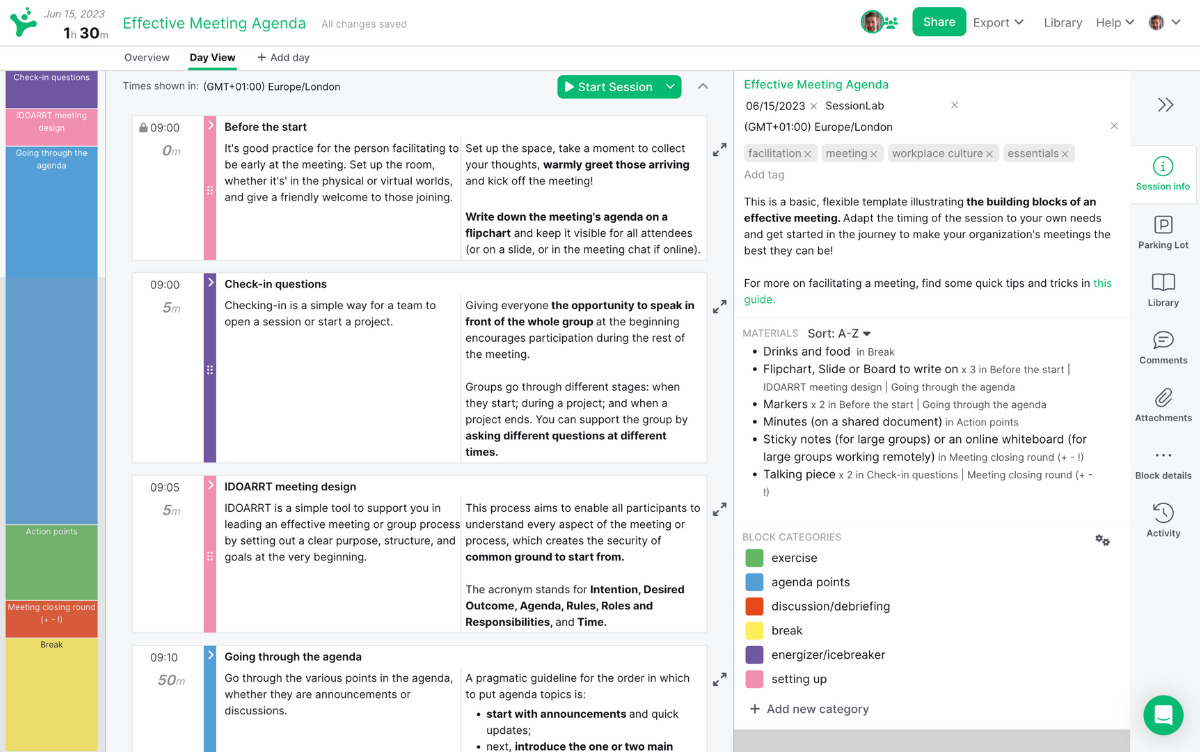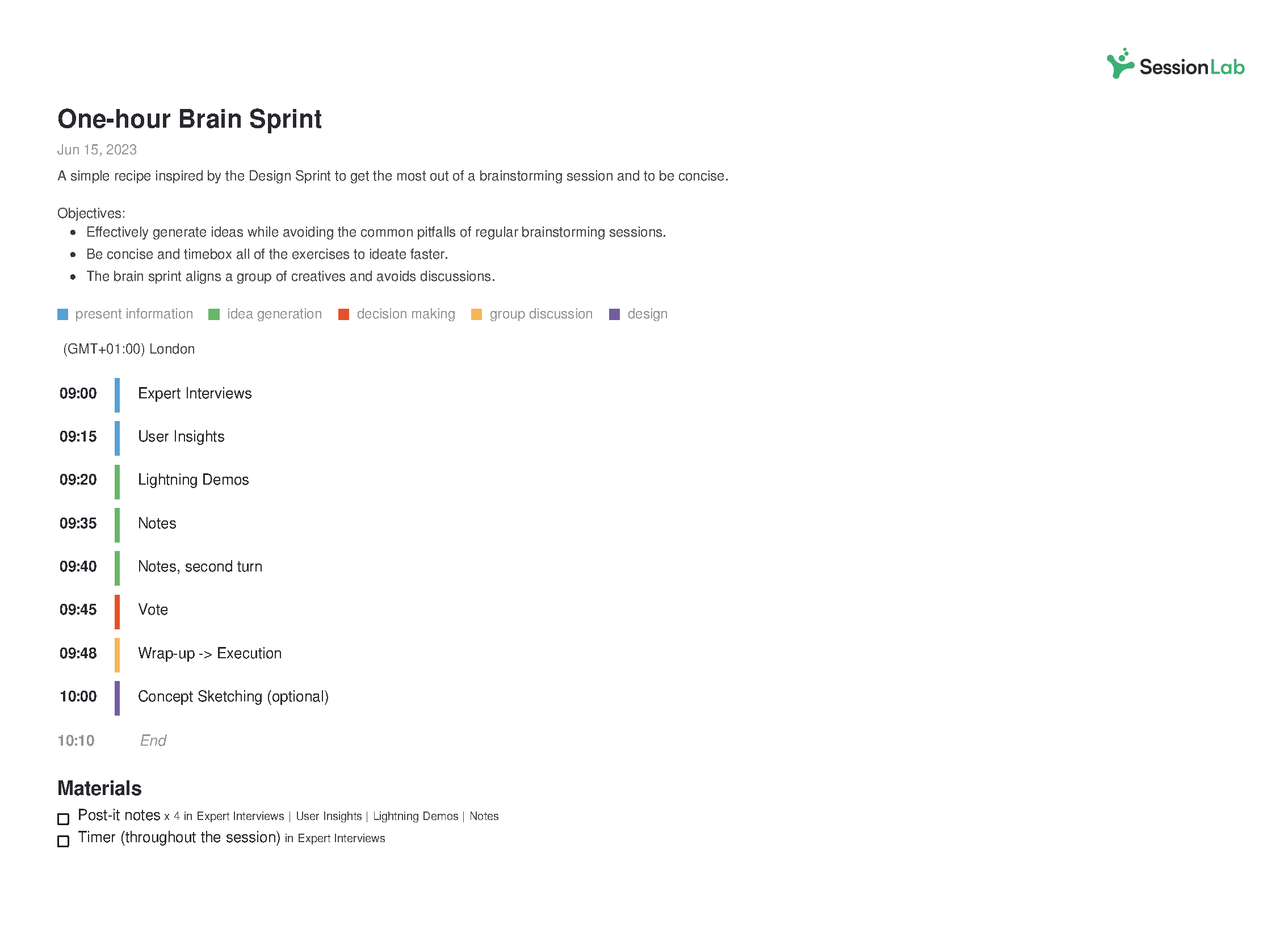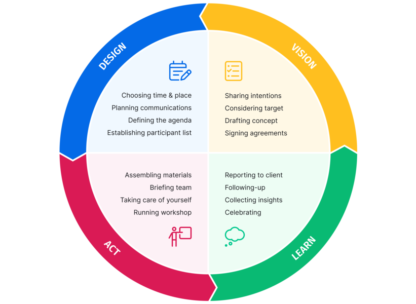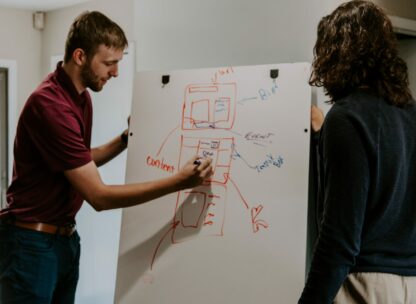
Building a team culture that helps everyone in your organization feel valued and empowered to do their best work should be a priority for every organization.
Without a healthy company culture, you can see toxic behavior, reduced productivity, and even lose members of the team!
But how can you and your team co-create an organizational culture you can be proud of and that makes your team want to come into work every day?
In this article, we’ll explore why team culture is important and discuss eight ways you can start to improve your culture today. Let's dig in!
What is team culture?
Team culture is a collection of values, behaviors, working practices, and beliefs that team members share while aiming to fulfill their collective purpose.
Every team has a culture. Even if you’ve never thought of it in those terms, consider all the ways in which your team interacts, what you value, and what is important to you as a group. That’s your culture.
Remember that team culture is a reflection of your shared values and working practices, and it will be formed by both collective and individual actions within the team.
The question you need to ask is whether you’ve thought about what your culture should be and what actions you have taken to achieve it.

What is good team culture?
A strong team culture is one where everyone in the team is aligned on purpose, values, behaviors, and working practices while also feeling they are celebrated as individuals.
In a good team culture, members of a team understand group and individual purpose as well as their role within the team. It’s vital to know why you are doing the work you are doing and believe in the goals and purpose of the team.
While positive team culture can emerge organically, it’s important that you come together to define your culture and align on what it is and how you live it. This might mean creating a culture statement or code of conduct, or simply working to strengthen the bonds and shared understanding between your team.
Here are some of the major elements of a great team culture:
- Clearly defined purpose and goals
- Alignment on team values & working practices
- Space for personal and professional growth
- Regular opportunities for open, honest discussion
- Flexible working hours
- Wellbeing programs
- Supportive policies on illness and vacation
- Opportunities for cross-function collaboration and connection
- Team code of conduct
- Transparent, communicative management
- Thoughtful systems for feedback
- Time and space to have fun as a team
Why is team culture important?
Team culture is important, whether you’re an organization of five people or five hundred. With a healthy team culture, everyone in your team can be happier, more engaged, and productive in the work that they do.
Your working environment is a direct result of the team culture you’ve created – it touches all aspects of the work you do as a group and can make a workplace successful or unbearable.
As mentioned above, every team develops a standardized way of interacting, working together, and demonstrating certain values. It’s important to define and co-create your team culture so you can ensure those interactions, working practices, and behaviors are those you want as a group.
Without a healthy and well-defined team culture, it’s easy to slip into a toxic or unproductive culture. As reported by HR magazine, as many as 27% of UK employees quit their job due to toxic workplace culture. Good team culture is an important ingredient in attracting and retaining great talent.
So whether you run a team building session or a workshop on company culture, it’s worth investing time and effort to define and improve your team culture.

What are the benefits of a good company culture?
When you and your team work together to define and improve your culture, the benefits can be seen in everything from everyday interactions to organizational outcomes.
Remember that company culture is a collection of your values, working practices, and behaviors. Your shared culture has an impact on every part of your organization and the benefits of improving your team culture will be felt at every level.
Here are some of the benefits of a good company culture:
- Improved motivation
- A happier, more engaged team
- Retention of top talent
- Better communication and collaboration
- Improved surfacing of problems and challenges
- Increased trust between team members
- Purposeful, value-based decision making
- Improved autonomy and efficiency
- Personal and professional growth
- Supportive working environment
How to improve team culture?
Improving the way your team works together and understands one another isn’t as hard as you might think. Creating a great company culture is something you can start doing immediately, in ways both big and small. What’s important is that you understand what you are trying to achieve and involve your entire team in the process.
Remember that team culture isn’t about giving everyone bean bag chairs, having a happy hour, and calling it a day. Thoughtful projects, team workshops, discussions, and incremental changes to working practices are all part of making a great team culture, though they can take time to have an impact.
In the next section, we’ll explore eight steps you can follow to build a strong team culture. You’ll also find include some tried and tested activities and methods you can use to engage your team members in the process too.
Define your purpose
Defining the purpose of your team is an important first step to building a productive team culture and improving team performance.
Without a shared purpose, it’s hard for a group to feel like they are pulling in the right direction and might not even understand why they are doing what they are doing. A poorly defined or nonexistent purpose can leave members feeling isolated or aimless – all of which can have a devastating effect on culture.
Co-creating and defining a clear purpose for your team can help ensure alignment, get people doing work that makes them happy, and improve communication between team members too.
The following activities are great for helping a team define its purpose and understand why you’re being brought together. This creates a foundation for a high performing teams to blossom and thrive.
Team Purpose & Culture
Defining what your shared purpose is and what you want your team culture to be is the first step towards having a culture you can be proud of. There are many ways you can go about defining your culture, though having a structured approach is vital. A framework like this method from Hyper Island can help ensure that everyone is heard, can contribute, and that the results are something you can stand behind as a group.
With this proven step-by-step process, you can co-create a living visual document for both team purpose and culture that can be referred to in the future and can grow with you.
Nine Whys
When working to align on team purpose and understand what we might bring to the table, it’s important to go deeper than the first, most obvious answer. For example, it’s reasonable to say that the purpose of a software company is to sell software but is that enough for people to get behind?
In order to craft a compelling purpose that a team culture can be built around, a group must go further and ask why are you making this software specifically? What problems are you trying to solve, and why is solving that problem important to you? This exercise from Liberating Structures challenges a group to go deeper and provides a framework for surfacing core purpose meaningfully.
Finding a compelling purpose and going beyond our initial assumptions or responses can help provide the foundation for a productive team and culture. Give it a go!
Purpose to Practice
For some groups, big picture thinking around team purpose is enough to feel galvanized, connected, and ready to move forward. For others, it’s important to connect core purpose to concrete actions at the outset in order to get them on board. In either case, helping stakeholders understand how their individual efforts and practices intersect with the overall purpose can help ensure that your purpose and culture are lived by everyone in an organization.
With this method, start by defining your shared purpose before introducing key elements—principles, participants, structure, and practices— that will help the team achieve that purpose in concrete terms.
Define and live your core values
Your core values are what differentiates your team from others, and they are a unifying force your team can get behind when making decisions and working together. For example, if your core values include kindness and honesty, these aspects should be highlighted and practiced by your team.
Your team’s culture goes hand in hand with your core values and often, teams that are having difficulty building a winning team culture are missing clearly defined core values. On other occasions, it’s a matter of teams having core values lost in a document somewhere and not truly living them.
Defining your core values is an activity that is best done with all team members and the activities below are a great way to do that. Once you’ve defined your values, it’s also vital that you live them as a team. Try celebrating great demonstrations of core values from individual team members during your monthly all hands and using them as part of your performance analysis cycles.
In my experience, a positive team culture is one in which your core values are well defined, front of mind and are regularly discussed among team members.
Team Canvas
Shared documents that clearly align everything from core values to how your team wants to collaborate are a hallmark of a high performing team culture. In this step-by-step activity, you and your team can first work to discuss, define and refine and desired team culture.
By involving all team members in the creation of the canvas, you can also create alignment on how each aspect should be done in practice. This makes living core values a much sim
Core Values Canvas
Building a positive team culture often starts with your core values, but it’s not always easy to decide on what they should be. This exercise is an effective way of simplifying the process and getting buy-in from every team member.
Start by explaining the importance of values and exploring what inflates and deflates your company’s culture. By then creating shared understanding of each value and then ranking their importance, you can effectively create the foundation for a great culture in which your values are front of mind.
Explore your Values
Understanding and sharing our individual values can be an important first step to defining values for your entire time. This exercise is designed to help participants quickly brainstorm values that are important to them before narrowing them down to their three core values. Follow this with a reflection and small group discussion to explore the importance of these values, as well as how they are seen and lived in everyday life.
A working environment where everyone feels able to live their values and are appreciated for doing so is a healthy, productive one!
Cocreate your culture and put it into writing
Team culture can often feel like an indescribable, effusive thing and your group might have different ideas of what your team culture is. If you want to ensure your whole team believes in your team culture and can contribute to it, it’s important to document and share what your team culture actually is.
Even more importantly, it’s best if you and your team create your team culture statement together. Not only can everyone get a shared understanding of what your team culture is, but you can ensure everyone can contribute to shaping what your team culture might be. A good team culture reflects the group as a whole – be sure to tap into the collective energy of your team and create this together.
These team culture exercises will help your group define your culture together and then create living documents that you can refer to and improve on in the future!
Culture Design Canvas
Team culture is a composite of purpose, values, behaviors, and agreed-upon working practices – in short, it’s a lot of elements to keep track of! Using a framework for defining your culture and touching upon all the vital elements is helpful in ensuring you and your team explore what makes a healthy team culture.
The Culture Design Canvas by Gustavo Razzetti is also useful in helping you map both your current and desired team culture and identify the steps you can take to reach a future state that works for everyone in a team. We’ve used this method internally at SessionLab and found it especially useful when trying to create change as a team!
Code of Conduct
Having your culture documented is often a vital step in ensuring that the group upholds that culture and understands what is expected from them in concrete terms. The challenge of many working agreements is that people may not have taken part in creating them, do not have a shared understanding of the contents, or simply disagree with some of the elements. This activity from Gamestorming methods is an effective way of co-creating a code of conduct that everyone can understand, uphold and live by.
Start by writing down “Meaningful” and “Pleasant” and inviting the group to share how they will make the meeting or workshop have those outcomes. By then asking participants to agree on what an idea means and how they might ensure it happens, you can effectively move towards creating a code of conduct you all feel empowered to follow.
Clarify how you want to work together
Teams are always composed of individuals who may have varying ideas of how they want to work together. Culture can be made or broken by how team members interact and work together.
A good team culture is one where everyone is treated how they want to be treated and you are aligned on working practices.
If someone does not feel their needs are being met or that their time or work is being respected, this can have a negative effect on team culture and working practices.
Take the time to define and clarify your working practices and you’ll see benefits across all team interactions – a huge boon to creating a happy, productive team culture!
- Alignment & Autonomy
- Generative Relationships STAR
- Team Remote Working Charter
- What I Need From You (WINFY)
Alignment & Autonomy
A strong team culture is one where people are aligned on purpose and empowered to work both individually and collectively on achieving that purpose. Often, this means giving all members of a group autonomy to work in the best way for them and enabling better-working flexibility.
Start by asking the team to reflect on times in the last six months where they felt more and less aligned and more or less autonomous. After reflecting, challenge your group to consider what would help them be more aligned but also, how they might be empowered to be autonomous and work better both individually and as a team.
You’ll often find that helping people discover the ways they can be autonomous in their work while supporting the shared goal can be transformative in how we spend our day-to-day and can massively improve team culture.
Generative Relationships STAR
From one perspective, team culture is formed and practiced by how we interact with the other people on our team. Considering what makes some of those relationships good and impactful while other relationships may be strained or difficult can help reveal how to make a healthier team culture.
With this method, invite each member of the group to individually assess the team using four characteristics: separateness, tuning, action and reason. Next, ask small groups to place dots on the STAR compass for how strongly they feel the team is performing on each point and discuss. By then identifying patterns and coming up with ideas for how to improve problem areas, your team can successfully create some action steps for improving team work and your collective culture.
Team Remote Working Charter
All teams benefit from having defined working practices and habits. A working charter can help everyone in the group know what’s expected of them, collaborate effectively and be successful in their role. What’s important is that any such charter should reflect the group, and ideally be co-created by members of that group.
When working in a virtual team, it’s helpful to acknowledge the unique and sometimes challenging nature of remote work in order to come up with a set of working practices that are fit for purpose. This method from Hyper Island is designed especially to help a virtual team define how they want to work together while surfacing some of the challenging elements of remote working in a productive way.
What I Need From You (WINFY)
It’s common for friction to emerge for teams working together, even if they’ve aligned on a shared purpose. Often, part of the problem can arise in how we communicate our needs and coordinate around that purpose. When communication breaks down or we don’t feel supported by our colleagues or managers, that can be massively damaging to team culture. If the issue persists it can even result in a toxic workplace – something we want to avoid!
What I Need From You is a simple framework for helping members of a team express their needs simply and clearly and repair relationships that might have been damaged under previous working practices. By using a structured response of either yes, no, I will try, or whatever, you can have an effective, meaningful conversation and move things forward with transparency from both sides.
Build trust
Good teams are built on trust. When it comes to sharing values, and discussing challenges productively, it’s hard to do so without first having trust. When a team really trusts one another, people feel able to share, raise concerns and contribute to the living team culture.
When trust in the workplace is in need of repair, it’s a real test of the culture you’ve built. Do people feel they can air concerns freely and can trust that they’ll be listened to? Can you work together towards a meaningful resolution and rebuild trust?
Trust, honesty, and openness are integral to building and maintaining a strong team culture. Whatever the age of your team, be sure to create space for building, maintaining, and repairing trust with these activities.
Trust
While it might seem that trust is universal, it’s common for members of a team to have varying interpretations of how trust is shown, received, and understood. Discussing how each of us might feel trusted and how we build and show trust and creating space to explore the differences and similarities can be generative. This exercise from Thiagi Group is designed expressly to do that.
Start by pre-preparing a set of around twenty trust cards, each with a single characteristic, behavior, attitude, habit, value, or beliefs around trust written on it. By then going through a process of creating and sharing their own trust cards and creating team trust posters, your group can effectively surface all those factors that affect trust in the workplace and think about how they can better build trust moving forward.
Translated Rant
Creating space for members of a team to be open and honest is a vital ingredient when building trust and improving organizational culture. The other side of the equation is trusting that the other person is willing to actively listen when you are honest and try to understand where you are coming from.
This activity from Erica Marx is a great way of helping people build the skills to understand others and support efforts to be honest and open. In pairs, have one player rant for sixty seconds about a pet peeve while the other is instructed to listen for what’s important to them and what they value.
After the rant, the second player then translates the rant into statements about what they care about while checking that they got it right. By switching roles and then debriefing, you can help your group better prepare for both being honest and receiving honesty in a productive way.
Life Map
It’s hard to trust people you don’t know well. When we get to know people better and in a more meaningful way, it’s much easier to interpret actions, work together productively and trust the other person.
Life Map is an activity designed to help people express what is important to them and share their stories in a simple, fun manner. Start by asking participants to draw a map of their lives from birth to the present day by using common symbols and simple pictures to note significant moments.
The result is a team of people who know each other better, feel more comfortable sharing what’s important to them, and are better positioned to contribute to an open and inclusive team culture.
Trust Battery
As with all aspects of team culture, it’s vital that a group is open and honest about where they are at and what problems they face with trust in order to move forward. Trust Battery is a great method for helping a group check-in with themselves and each other before then understanding what they need to do in order to build or repair trust.
Start by inviting participants to measure the level of their trust battery with each of their coworkers. Remember to be honest and ask your group to reflect on how they might improve their trust batteries. During the debrief, it’s also important to note where people are misaligned and find space to surface why this might be. Be sure to explore this fully and encourage everyone to consider what actions they might take to improve mutual trust for the biggest impact!
Team culture can be broadly understood as a set of shared values and agreed-upon behaviors that determine how a group interacts and works together.
Taking the time to align on those values and behaviors and ensure everyone is one the same page is integral in building a strong team culture that sticks.
Not only this, but teams that understand one another are better able to navigate issues, support one another, and stay happy. Without a shared understanding of roles, working practices, and how our actions affect others, it can be hard to create an effective team culture.
Let’s look at some activities that can help create a shared understanding among the members of a team.
Team Self Assessment
All teams are composed of individuals with different roles, needs, and working practices. Developing a shared understanding of how everyone will work together is a key part of building your team culture. Without defining and clarifying these elements, it’s hard for a group to align and come together meaningfully.
This method from Hyper Island provides a framework for allowing a team to self-assess and explore how they might better work together across six categories ranging from team relations & environment to responsibility and productivity. By the end of the activity, you’ll have a clear document you can use as a point of shared understanding for your team!
W³ – What, So What, Now What?
Any working group of people may encounter conflict or differences of opinion from time to time. If these situations are not properly discussed and learned from, the result can be disgruntled employees, misaligned teams, and a toxic work environment.
This activity is designed to help a group methodically explore and debrief an event or process to understand what happened, why it is important, and then decide how to improve and move forward together. Start by working individually to describe what happened before moving to small group work. By then debriefing and deciding actions as a full group, you’ll ensure everyone is heard and can be collectively understood. A great foundation for a productive team culture!
Circles of Influence
Companies and teams can be increasingly complex as they grow. This complexity can be part of the reason for team misalignment and if not properly managed, can damage your team culture too. Build a more conscientious team culture by using this exercise from Hyper Island!
Start by asking everyone to write down things that meaningfully impact the team, both internally and externally. Next, invite the group to decide whether these items fall in under the circle of influence or the circle of concern. Debrief and discuss in order to help everyone understand and align on what items they should or should not focus energy on in the future.
History Map
Creating a shared understanding of a team’s history or collective experience is a vital part of great team culture. This activity is designed to help a group reflect on a period or project collectively while allowing everyone space to contribute both their individual experiences too.
Start with a large whiteboard or piece of paper and include a few key events or dates to create a timeline for the reflection period. Next, invite the group to add elements of their experience to the history map using words, images, drawings and whatever else you feel is appropriate.
After some silent reflection, invite participants to share a single moment that has been most impactful to them. By creating a collective history map, your group can reflect on all aspects of a project and better align with one another too!
Appreciate and celebrate one another
After a team has aligned on their culture and values, it’s important to celebrate when you actively live those values and appreciate everyone’s efforts. It’s a vital part of keeping your team culture alive!
Going further and showing appreciation for each other as individuals is also a vital part of a healthy team culture. When we are seen and valued, it makes us feel good and more connected to one another as a group.
Try using some of these activities to help a group appreciate one another and build an appreciative team culture where everyone is seen and valued.
Appreciations Exercise
Hearing about your strengths and receiving positive feedback from others is an effective way of building bonds and creating a healthy team culture. It feels good to feel valued by your teammates! For this exercise, start by having each participant write down their names on the bottom of a piece of paper before handing it to the person to their left. Each person then writes down a few words to describe what they value most about the person named on the page.
Once the paper has come back to the original person, have a few moments to read before having each person read out the strength or value they liked the most. By affirming this strength on paper and then aloud, the appreciation is more likely to have lasting impact.
Myers-Briggs Team Reflection
Personality tests can be great tools for improving group and personal understanding. Being aware of both your own personality type and those of your colleagues can be massively helpful for your team. Not only can it help a group understand actions and motivations, but it can also make it easy to see and celebrate strengths too.
Whatever personality type tool you use, be sure to take the time for groups to reflect on the different aspects of their results and discuss as a team. The resulting discussions and celebrations of one another through such a tool can often be as helpful as the initial result.
Living Core Values
An environment where team members regularly give kudos to each other is one signifier of a great company culture. Organising appreciation giving rituals around your values is both a great way to celebrate what you’ve done well but also ensure that your values are continually practiced and reinforced.
The best team cultures I’ve been a part of have always spent time celebrating individual and collective efforts. Use this exercise to not only highlight how people are living your company’s values but also create space for thanks and celebration.
Have fun together!
An example of poor team culture is when people don’t feel connected to one another. Of all the methods there are for building team culture, having fun as a team can be one of the most transformative. Simply feeling more connected and getting to know each other outside of working roles can be instrumental in helping your team culture grow.
You might have away days, team events, and wellbeing programs that focus on introducing fun in the workplace, but it’s important to note that you can have fun together during meetings and workshops with simple icebreakers games or energizers.
Remember that team building games and activities of all shapes and sizes can be useful when building your culture!
Laughing and having fun together between tough tasks and periods of hard work can be integral to building a great team culture, even if it’s just ten minutes in your day. Try these games and activities if you want an easy, low-impact way to start building a fun team culture.
Bang
Having fun as a group is especially important for new teams who are just getting to know one another. Bang is a fun icebreaker game that is simple to teach and can instantly generate a good atmosphere in a group.
Start by getting the group to stand in a circle and choose one person to stand in the middle as the sheriff. The sheriff spins around before stopping, pointing at someone and shouting bang. The target must duck to avoid the shot while the person on their left and right must then shout the name of the other person. The last to shout the other person’s name is then out of the game. Repeat until you have just two people left and have a duel to finish the game!
Doodling Together
Tapping into some of the things we did as kids and unleashing our inner child can be especially effective when starting to build your company culture. Finding space to have fun, collaborate, and celebrate creativity should always be encouraged.
With Doodling Together, start by handing postcards or small pieces of paper to your group. Next, invite each person to draw a form before passing their card to the next person. The next person then adds an animal to the form and passes the card on again.
By adding new elements with each pass and encouraging silliness, you and your group can establish creative confidence while having fun too!
Rock, Paper, Scissors (Tournament)
Simplicity is king when it comes to finding space to have fun as a team while at work. If you want to find a quick and easy way to inject fun into a team workshop, a rock, paper, scissors tournament is a great place to start.
Start by asking everyone in a group to pair up and play rock, paper, scissors. The loser then becomes a fan of the winner who cheers them on in the next round. Continue until you have two large crowds cheering on the final pairing. Add additional rules or conditions for cheering if you like and don’t be afraid to run this one in virtual or hybrid settings too!
GIF challenge
Having fun as a group is especially important for virtual teams who may not have as many opportunities for spontaneous games or exercises. GIF challenge is a simple activity that can work as a quick icebreaker game or be used as part of an ongoing tournament or challenge.
Start by posing a question or challenge in your messaging app or on your online whiteboard. Each participant must quickly respond using a fun and appropriate GIF. Anonymous posting is best so you can then have the group vote on their favorite and you can select a winner! Run several rounds and allocate points to turn this into a tournament and give out prizes to the winner for bonus credit!
Team culture is too important to leave to chance
Defining and improving your team culture with a structured workshop is an effective way to engage your team and create a culture you can be proud of.
With SessionLab, it’s easy to create an effective agenda for your culture workshop. Drag, drop and reorder blocks to build your agenda in minutes.
Your session timing adjusts automatically as you make changes and when you’re done, you can share a beautiful printout with your colleagues and participants.
Explore how teams use SessionLab to collaboratively design effective workshops or watch this five minute video to see the planner in action!

Wrap up
Building an enduring team culture doesn’t happen overnight, but that doesn’t mean that there aren’t things you can do today to improve your culture. Being honest about what needs to improve, defining your ideal culture, and taking pragmatic steps to achieve a better team culture are great ways to get started.
It’s so vital to try and cultivate a team culture where everyone feels seen and heard and where their values are celebrated. Not only will you see an improvement in motivation and productivity, but you’ll have a happier, more connected team too!
Did you have any tips for building team culture? Have you found any of the above methods particularly useful? We’d love to hear from you in the comments below!



Your tips was helpful indeed for my group session I didn’t have any ice breakers so the group is having fun now that we get to cheer a bit in the middle of our session.thank you